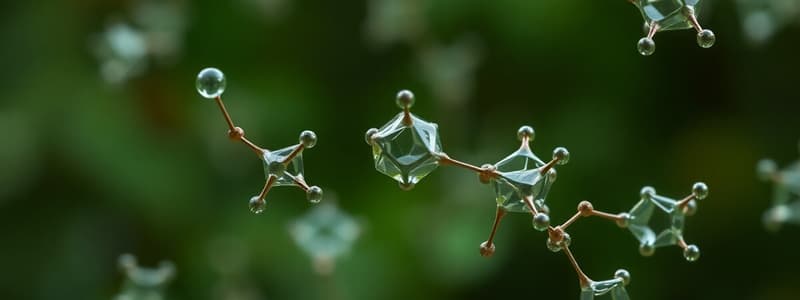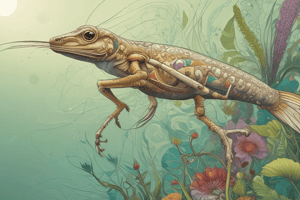Podcast
Questions and Answers
What is the scientific study of life called?
What is the scientific study of life called?
- Biology (correct)
- Geology
- Physics
- Chemistry
Which of the following is a characteristic of life?
Which of the following is a characteristic of life?
- Randomness
- Disorder
- Reproduction (correct)
- Inertness
What is the basic unit of life?
What is the basic unit of life?
- Tissue
- Cell (correct)
- Organelle
- Organ
Which of these is NOT a level of biological organization?
Which of these is NOT a level of biological organization?
What does DNA carry?
What does DNA carry?
Which cell structure contains the cell's DNA?
Which cell structure contains the cell's DNA?
What is the process of change in the characteristics of a species over time called?
What is the process of change in the characteristics of a species over time called?
Which process do plants use to convert light energy into chemical energy?
Which process do plants use to convert light energy into chemical energy?
What do we call animals that consume other organisms to get energy?
What do we call animals that consume other organisms to get energy?
Which scientist proposed the theory of evolution by natural selection?
Which scientist proposed the theory of evolution by natural selection?
What is the study of interactions between organisms and their environment called?
What is the study of interactions between organisms and their environment called?
Which of the following describes all ecosystems on Earth?
Which of the following describes all ecosystems on Earth?
What is the function of ribosomes?
What is the function of ribosomes?
What is the waxy layer on plant leaves that prevents water loss called?
What is the waxy layer on plant leaves that prevents water loss called?
Which of the following is an example of a microorganism?
Which of the following is an example of a microorganism?
What is the main function of the roots of a plant?
What is the main function of the roots of a plant?
What is biotechnology?
What is biotechnology?
Which of these is a key characteristic specific to animals?
Which of these is a key characteristic specific to animals?
What is the function of the Golgi apparatus?
What is the function of the Golgi apparatus?
What is the transmission of traits from parents to offspring called?
What is the transmission of traits from parents to offspring called?
Flashcards
What is Biology?
What is Biology?
The scientific study of life, from cellular processes to ecosystem interactions.
Order (in living things)
Order (in living things)
Organisms are highly structured and organized.
Sensitivity
Sensitivity
Ability to respond to stimuli or changes in the environment.
Reproduction
Reproduction
Signup and view all the flashcards
Adaptation
Adaptation
Signup and view all the flashcards
Growth and Development
Growth and Development
Signup and view all the flashcards
Homeostasis
Homeostasis
Signup and view all the flashcards
Energy Processing
Energy Processing
Signup and view all the flashcards
Evolution
Evolution
Signup and view all the flashcards
Molecule
Molecule
Signup and view all the flashcards
Organelle
Organelle
Signup and view all the flashcards
Cell
Cell
Signup and view all the flashcards
Tissue
Tissue
Signup and view all the flashcards
Organ
Organ
Signup and view all the flashcards
Organ System
Organ System
Signup and view all the flashcards
Organism
Organism
Signup and view all the flashcards
Population
Population
Signup and view all the flashcards
Community
Community
Signup and view all the flashcards
Ecosystem
Ecosystem
Signup and view all the flashcards
Biosphere
Biosphere
Signup and view all the flashcards
Study Notes
- Biology is the scientific study of life, encompassing topics from microscopic processes within cells to ecosystem interactions.
Characteristics of Life
- Living organisms exhibit key characteristics.
- Order: Organisms possess highly organized structures.
- Sensitivity or Response to Stimuli: Organisms respond to environmental changes.
- Reproduction: Organisms create new organisms through reproduction.
- Adaptation: Organisms evolve adaptations for their environment.
- Growth and Development: Organisms grow and develop via genetic information.
- Regulation/Homeostasis: Organisms maintain stable internal conditions.
- Energy Processing: Organisms use energy to power activities.
- Evolution: Populations of organisms evolve over time.
Levels of Biological Organization
- Life is organized into a hierarchy of levels.
- Molecules: Atoms combine to form molecules.
- Organelles: Molecules form organelles, which are functional components of cells.
- Cells: The basic unit of life.
- Tissues: Groups of cells performing similar functions.
- Organs and Organ Systems: Organs are composed of tissues and perform specific functions; organ systems consist of multiple organs working together.
- Organisms: Individual living entities.
- Populations: Groups of individuals of the same species in an area.
- Communities: Populations of different species in an area.
- Ecosystems: Communities and their physical environment.
- Biosphere: All ecosystems on Earth.
Cell Structure and Function
- The cell is the basic unit of life.
- Cells are either prokaryotic or eukaryotic.
- Prokaryotic cells lack a nucleus and complex organelles.
- Eukaryotic cells possess a nucleus and membrane-bound organelles.
- Nucleus: Contains the cell's DNA.
- Ribosomes: Synthesize proteins.
- Endoplasmic Reticulum (ER): Involved in protein and lipid synthesis.
- Golgi Apparatus: Processes and packages proteins.
- Mitochondria: Generate ATP through cellular respiration.
- Lysosomes: Contain enzymes for breaking down cellular waste.
- Plasma Membrane: The outer boundary of the cell, controls entry and exit.
Genetics and Heredity
- Genes, composed of DNA, are the units of heredity.
- DNA (deoxyribonucleic acid) carries genetic information.
- Chromosomes are structures containing DNA.
- Genes encode instructions for building proteins.
- Genotype: Genetic makeup of an organism.
- Phenotype: Observable characteristics influenced by genotype and environment.
- Inheritance: Transmission of traits from parents to offspring.
- Meiosis: Cell division that produces gametes (sperm and egg cells) with half the number of chromosomes.
- Fertilization: Fusion of gametes to restore the full chromosome number and create a new organism.
Evolution
- Evolution is the process of change in species characteristics over generations.
- Natural selection is a primary mechanism; advantageous traits become more common in a population.
- Charles Darwin proposed the theory of evolution by natural selection.
- Adaptation: A trait that improves survival and reproduction in a specific environment.
- The fossil record shows the history of life to evidence evolution.
- Comparative anatomy shows structural similarities between species to evidence evolution.
- Embryology shows similarities in embryonic development to evidence evolution.
- Molecular biology shows similarities in DNA and protein sequences to evidence evolution.
- Biogeography, examining species distribution on Earth, evidences evolution.
Ecology
- Ecology is the study of interactions between organisms and their environment.
- Population: A group of individuals of the same species in the same area.
- Community: All populations of different species in the same area.
- Ecosystem: A community of organisms in an area and their physical environment.
- Biosphere: The sum of all ecosystems on Earth.
- Trophic Levels describe the feeding positions in an ecosystem.
- Producers: Autotrophs, produce their own food (e.g., plants).
- Consumers: Heterotrophs obtain energy by consuming other organisms.
- Decomposers: Break down dead organisms and waste.
- Food chains and food webs: Show the flow of energy and nutrients through an ecosystem.
- Biogeochemical cycles: The movement of elements (e.g., carbon, nitrogen, water) through ecosystems.
Plant Biology
- Plants are multicellular, eukaryotic organisms.
- Photosynthesis: Plants convert light energy into chemical energy (sugars).
- Roots: Anchor the plant and absorb water and nutrients.
- Stems: Support the plant and transport water and nutrients.
- Leaves: Sites of photosynthesis.
- Flowers: Reproductive structures.
- Vascular tissue transports water and nutrients for plant adaptation to terrestrial life.
- The cuticle, a waxy layer, prevents water loss as a plant adaptation to terrestrial life.
- Stomata are pores for gas exchange as a plant adaptation to terrestrial life.
- Pollination is the transfer of pollen from the stamen to the pistil in plant reproduction.
- Fertilization is the fusion of sperm and egg to form a zygote in plant reproduction.
- Seed dispersal spreads seeds to new locations in plant reproduction.
Animal Biology
- Animals are multicellular, eukaryotic organisms.
- Animals are heterotrophic, obtaining energy by consuming other organisms.
- Most animals can move.
- Reproduction is primarily sexual in animals.
- Specialized tissues include nervous, muscle, epithelial, and connective tissues.
- Invertebrates are animals without a backbone.
- Vertebrates are animals with a backbone.
- The nervous system coordinates body functions through electrical and chemical signals.
- The endocrine system regulates body functions through hormones.
- The circulatory system transports blood, oxygen, and nutrients.
- The respiratory system exchanges gases with the environment.
- The digestive system breaks down food for absorption.
- The excretory system removes waste products.
- The immune system protects the body from pathogens.
- The reproductive system is involved in reproduction.
Microbiology
- Microbiology is the study of microorganisms, including bacteria, archaea, viruses, fungi, and protists.
- Bacteria are prokaryotic, single-celled organisms.
- Archaea are prokaryotic organisms, often living in extreme environments.
- Viruses are non-cellular entities requiring a host cell to replicate.
- Fungi are eukaryotic organisms, including yeasts, molds, and mushrooms.
- Protists are eukaryotic organisms, mostly unicellular.
- Microorganisms play roles in nutrient cycling as decomposers break down organic matter.
- Microorganisms play roles in disease when pathogens cause infectious diseases.
- Microorganisms used in food production, medicine, etc in biotechnology.
Biotechnology
- Biotechnology uses biological systems, organisms, or their parts to develop or create different products.
- Genetic engineering modifies an organism's genetic material.
- Cloning creates genetically identical copies of an organism.
- Polymerase chain reaction (PCR) amplifies DNA.
- Medicine: Developing new drugs and therapies uses biotechnology.
- Agriculture: Creating genetically modified crops uses biotechnology.
- Environmental science: Bioremediation of pollutants uses biotechnology.
- Forensics: DNA fingerprinting for identification uses biotechnology.
Studying That Suits You
Use AI to generate personalized quizzes and flashcards to suit your learning preferences.




